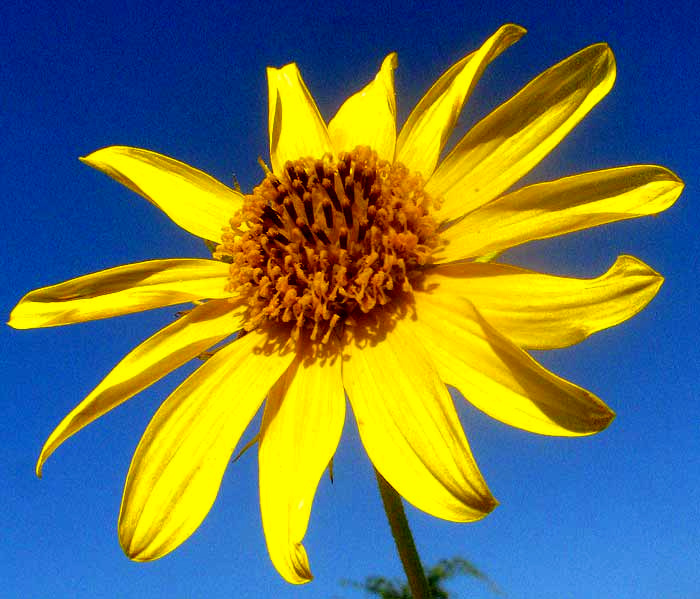
Of all the world's flowering-plant families, the two with the most species are the Orchid and Composite Families. It's debated which is the biggest.
These big families are also considered among the most "modern," or recently evolved, as well as some of the most "successful," in terms of sheer numbers of forms and individual plants. About 23,000 Composite Family species are recognized. The online Flora of North America includes 2413 species found just in North America.
THE HUGE COMPOSITE FAMILY
IDENTIFICATION KEYS IN
FLORA OF NORTH AMERICA
If you can handle the Composite Family's specialized terms and concepts you can "key out" your unknown finds in the Asteraceae section of the Flora of North America site. Choose a key among those near the bottom of the long page you arrive at when you click the above link.
Here are some of the best-known Composite or Aster Family members that might appear in a typical backyard garden: Chicory, dandelion, chrysanthemum, yarrow, coreopsis, sunflower, Spanish needle, dahlia, zinnia, goldenrod, fleabane, aster, sneezeweed, groundsel, eupatorium, ageratum, lettuce, thistle, ironweed, cosmos, and Black-eyed Susan.
In other words, if you're going to understand the composite blossoms you encounter as a backyard naturalist, at some time or another you must come to terms with the composites' very unique flowers.
COMPOSITE FAMILY FLOWER STRUCTURE
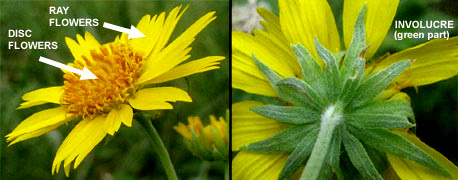
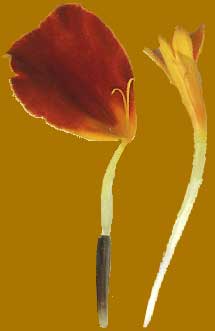
Above you see two views of a typical Composite Family flowering head, that of the Cowpen Daisy, Verbesina enceliodes. At the left of the above picture a top view of the head is provided, while at the right, that's a bottom view. Notice that a "flowering head" is being referred to, not a flower. The big thing about Composite Family flower structure is that in the above picture you're not seeing two views of one flower, but rather two views of flowering heads composed of many flowers, known as florets. Technically, flowering heads may be called "capitula."
Two main floret types are recognized: disc flowers (also written "disk") and ray flowers. As shown in the photo at the right, of marigold's two kinds of florets, disc flowers have cylindrical corollas, while ray flowers have flat, blade-like ones.
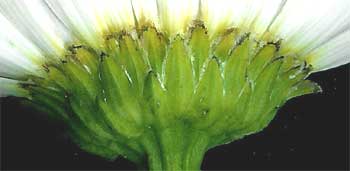
Beneath the flowering head there's a collection of modified leaves, or bracts, forming the involucre, shown above. That's the involucre of a chrysanthemum flower. Each individual bract forming the involucre is technically known as a phyllary (FIL-uh-ree). Note that the chrysanthemum's phyllaries are somewhat different from those of the Cowpen Daisy seen earlier. When identifying species in the Composite Family, noticing the bracts is very important, for they come in many forms and sizes. You might enjoy looking over our page examining the varied the world of Composite Family involucre bracts.

For practice with disc and ray flowers, look at the marigold blossom at the left, broken apart to show the main features. Notice how the ray flowers surround the disc flowers.
Also, note the cypselae (SIP-suh-lee), which are special kinds of one-seeded fruits occurring in the Composite Family (singular cypsela, pronounced SIP-suh-luh). The cypselae are neatly stacked beside one another atop the low, conical, platform-like receptacle. The cypselae at the very top of the receptacle are white because they are still immature. Later they will turn black.
THREE KINDS OF COMPOSITE FLOWER
When you begin trying to identify a composite flower, the first thing to notice is which of the three kinds of composite flowering heads you have. Here are the three basic flower-head types:
- Heads composed of only ray flowers, as in dandelion (shown at the right), chicory, endive, and wild lettuce.
- Heads composed of only disc flowers, as in eupatorium (the white flowers at the right), ageratum, thistles, and burdock.
- Heads composed of both disc and ray flowers, with disc flowers tightly packed in the head's "eye," while enlarged ray flowers function as petals radiating outward from the eye. Species in this group include sunflowers, asters, Black-eyed Susans, chrysanthemums, dahlias, and the red zinnia pictured at the right. In the zinnia, the yellow, five-lobed disc flowers in the head's center are clearly visible, surrounded by red, petal-like ray flowers.
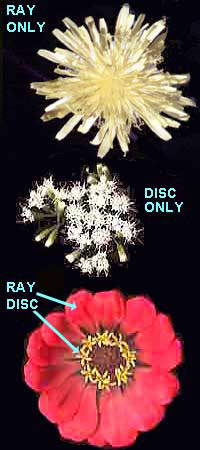
FLORET STRUCTURE
Once composite-blossom basics are understood, you should seek out a composite flowering head, remove a tiny disc or ray floret from the head, and see if you can find the flower's basic parts. If you don't understand terms like style and stamen, you may want to consult our Standard Blossom Page as you read through the following. Here are a couple of composite-family peculiarities to keep in mind:
- STAMENS: Stamens in disc and ray florets number four or five, and are fused together by their anthers to form a cylinder around the style. That's shown at the right, from a marigold head.
- PISTILS: As in all flowers, the pistil comprises stigma, style and ovary. In each composite floret a thread-like style, the ovary's "neck," passes up through the anther-cylinder to two long style branches projecting above the anthers. The style branches bear tiny bumps or hairlike items called "stigmatic papillae", which is where pollen grains germinate. The ovary is situated below the corolla and sexual parts, so Composite Family ovaries are "inferior," as described on our Standard Blossom page.
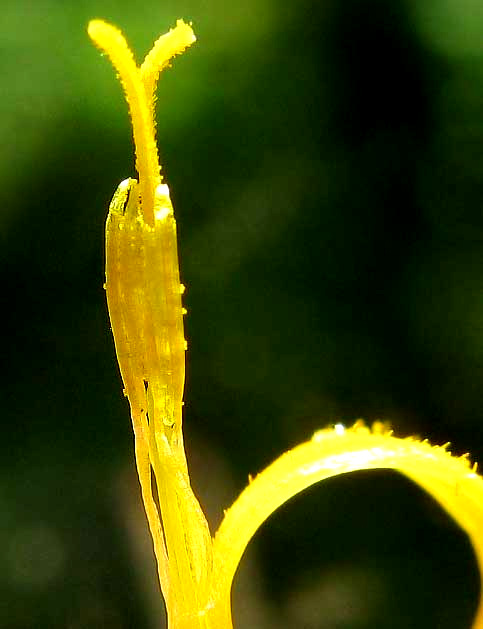
Pistils develop into fruits. The Composite Family's inferior ovary matures into a unique kind of fruit called a cypsela (SIP-suh-luh). The plural is "cypselae" In older texts, cypselae are referred to as "achenes." Cypselae are dry (not fleshy) fruits with only one seed, and the fruit does not split open during seed dispersal. Technically speaking, when we munch on sunflower "seeds," we're eating one-seeded, cypsela-type fruits.
PAPPUSES
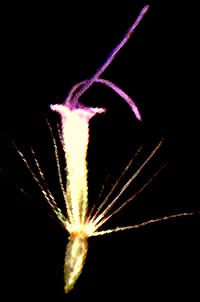
Atop the cypselae of many members of the Composite Family, instead of the sepals you find atop inferior ovaries of other plant families, there are special projections known collectively as pappuses, or "pappi." At the right, a pappus arises atop the cypsela, and from the base of the disc corolla, of a eupatorium disc floret. Later, this pappus composed of "capillary hairs" will serve as a parachute enabling the mature cypsela to be blown by the wind into new territory. Below you see a mature cypsela of the Bull Thistle, Cirsium vulgare, its parachute-like pappus ready to catch the wind:
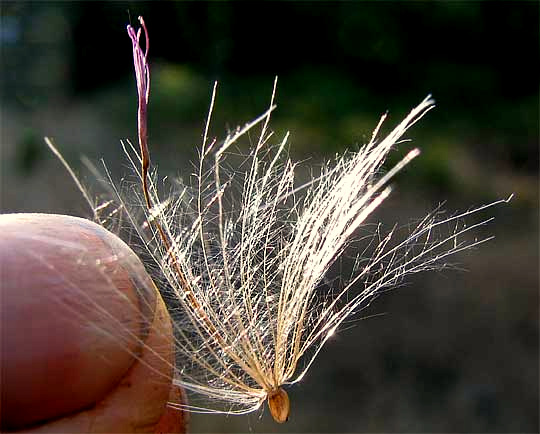
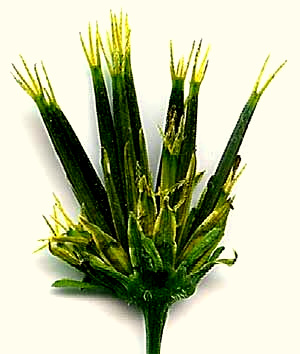
Pappuses come in an amazing variety of forms, not just hairlike bristles as shown above. At the right, you see cypselae of Bidens bipinnata, one of several species known as "beggar-ticks" or "sticktights." Instead of soft, hairlike bristles, sharp, stiff "awns" top these cypselae, enabling the cypselae to stick to animal fur (or hikers' pants), where they are effectively transported into new territory to be sown.
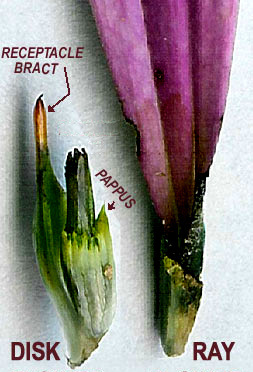
Common thistles have feathery bristles united into a ring at the base. Sunflower pappuses consist of two sharp scales that fall off when the achene is mature. Echinacea pappuses are cup-like crowns, as shown in the photo at the left. Many flowers have no pappus at all.
On and on pappus variations go, typically all the members of a genus possessing similar types. Needless to say, when identifying composite blossoms, the pappus is one of the most important features to note.
PALEAE
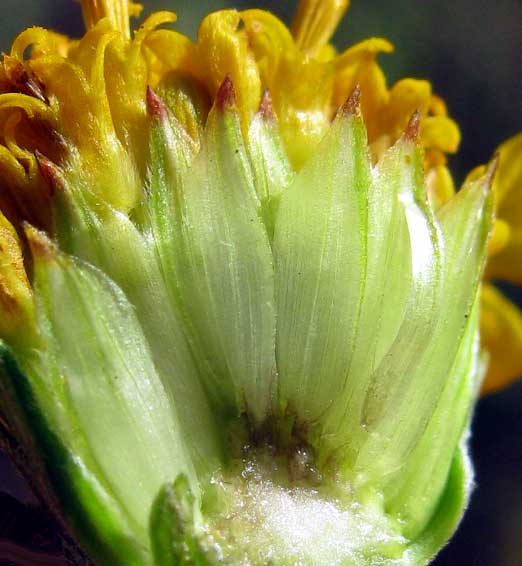
When identifying members of the Composite or Aster Family, one more obscure feature often is very helpful, because the feature appears in some genera but not others. At the right, you see what we're referring to. In that broken-open flowering head of the Sunflower Goldeneye, Viguiera dentata, you see thin, papery, scale-like things wrapping most of the way around the bottom of each floret. Those are paleae, sometimes in text books referred to as "chaff."
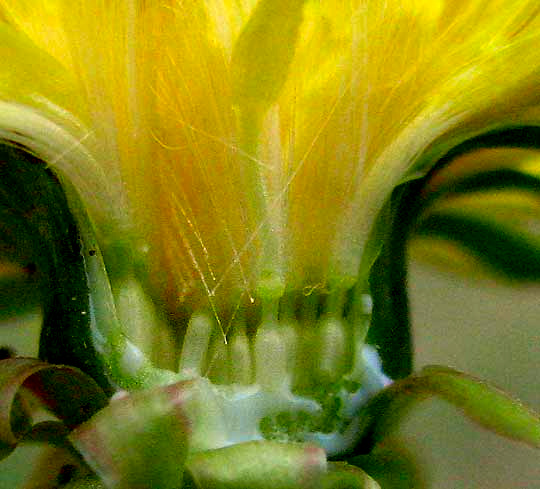
Compare the Sunflower Goldeneye's situation with that of the Common Dandelion, Taraxacum officinale, shown at the left. In that similarly broken-open flower, the bottoms of each individual floret stand side by side like necked bottles of milk, with no paleae between them. In this special case, though, it looks like some of the milk bottles have broken. The white, milky liquid is white latex issuing from the broken receptacle, a typical feature of all dandelions.